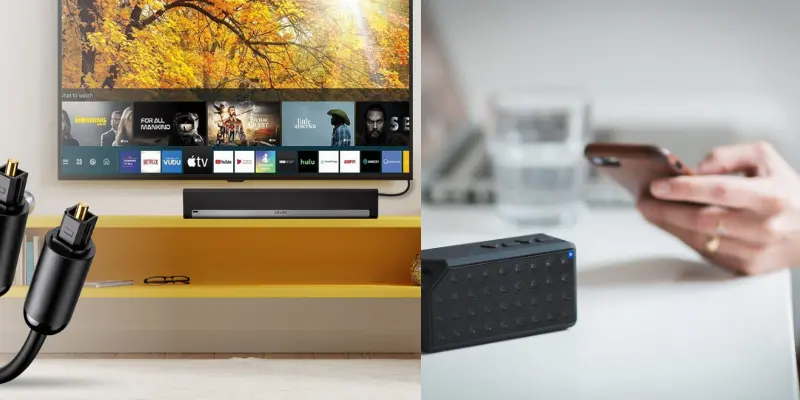How to Connect Sonos Speakers to TV-5 Basic Steps Amazing Guide
How to Connect Sonos Speakers to TV
Sonos speakers are known for their superior sound quality and ease of use, making them a popular choice for home audio systems. Connecting Sonos speakers to your TV can enhance your viewing experience by delivering immersive, theater-like sound. Whether you’re using a Sonos soundbar or other Sonos speakers, this comprehensive guide will walk you through the process step by step.
We will cover the various methods for connecting Sonos speakers to your TV, offer troubleshooting tips, and answer frequently asked questions to ensure you get the best performance from your system.
Sonos Products Compatible with TV Connections
Before we dive into the setup process, it’s essential to know which Sonos products can be directly connected to a TV. Here are some of the most common Sonos devices that integrate seamlessly with televisions:
- Sonos Arc:
A premium soundbar with Dolby Atmos support. - Sonos Beam:
A compact smart soundbar. - Sonos Playbar:
A discontinued soundbar, still in use in many setups. - Sonos Playbase:
A TV base with built-in speakers. - Sonos Amp:
- Can be used to power traditional speakers for TV audio.
While these products are designed for TV connections, other Sonos speakers can be part of your home theater setup when combined with a soundbar or an Amp.
Prerequisites for Connecting Sonos to a TV
Before starting, ensure you have the following:
- Sonos soundbar or Amp for TV connectivity.
- HDMI ARC/eARC or Optical port on your TV.
- HDMI or Optical cable (depending on your TV’s input options).
- Sonos App (Sonos S2) installed on your mobile device.
- Wi-Fi network: Sonos speakers connect wirelessly for advanced features and control through the app.
Step-by-Step Guide: Connecting Sonos to TV Using HDMI ARC/eARC
If your TV has an HDMI ARC (Audio Return Channel) or eARC (enhanced ARC) port, this is the best way to connect your Sonos soundbar. HDMI ARC supports high-quality audio transmission and allows two-way communication between the TV and soundbar.
Step 1: Identify the HDMI ARC Port
- Look for the HDMI ARC or HDMI eARC label on the back of your TV.
- This port allows the TV to send audio to the soundbar and receive commands back.
Step 2: Connect the HDMI Cable
- Take the HDMI cable provided with your Sonos soundbar and plug one end into the HDMI ARC/eARC port on your TV.
- Plug the other end into the HDMI port on your Sonos soundbar.
Step 3: Set Up Audio Output on TV
- Go to your TV’s Audio Settings and select HDMI ARC or eARC as the preferred audio output.
- Ensure that TV speakers are turned off to avoid conflicting audio signals.
Step 4: Use the Sonos App to Complete Setup
- Open the Sonos App on your mobile device.
- If this is your first Sonos device, tap on Set up a new system and follow the on-screen instructions.
- The app will guide you through connecting your soundbar to the Wi-Fi network and optimizing settings.
Step 5: Test Audio
- Play something on your TV, and the sound should now come through the Sonos soundbar.
- You can control the volume directly from your TV remote, thanks to HDMI ARC’s two-way communication.
Step-by-Step Guide: Connecting Sonos to TV Using Optical Cable

If your TV doesn’t have an HDMI ARC or eARC port, you can use an optical cable to connect the Sonos soundbar.
Step 1: Identify the Optical Port
- Locate the optical audio output on the back of your TV. This may be labeled as Digital Audio Out.
Step 2: Connect the Optical Cable
- Connect the optical cable from your TV’s optical audio output to the optical port on the back of your Sonos soundbar.
- If using a Sonos Beam, you will need to use the HDMI-to-optical adapter provided in the box.
Step 3: Set Up Audio Output on TV
- In your TV’s Audio Settings, select Optical or Digital Audio Out as the audio output.
- Disable the TV’s internal speakers to prevent sound from coming from both sources.
Step 4: Complete the Setup with Sonos App
- Open the Sonos App on your device.
- If the soundbar is already part of your Sonos system, it should recognize the TV connection automatically.
- If this is a new setup, follow the app’s instructions to connect the soundbar to your system.
Step 5: Test the Connection
- Play audio from your TV to confirm that the sound is coming through your Sonos soundbar.
- Note that, unlike HDMI ARC, the optical cable doesn’t allow for volume control via the TV remote, so you’ll need to adjust volume through the Sonos app or an integrated voice assistant.
Setting Up Surround Sound with Sonos
Sonos allows you to create a full home theater experience by adding rear speakers (like the Sonos One or Sonos Five) and a subwoofer (Sonos Sub) to your soundbar setup.
Step 1: Add Rear Speakers
- In the Sonos App, go to Settings > System > Add Surround Speakers.
- Select the two Sonos speakers you want to use as rear speakers and follow the instructions to pair them with your soundbar.
Step 2: Add Sonos Sub
- To add the Sonos Sub, go to Settings > System > Add Sub and follow the instructions.
Step 3: Optimize the Sound
- Once your surround sound system is set up, you can use Trueplay Tuning (for iOS devices) to optimize the audio output for your room’s acoustics.
Using Sonos with TV Streaming Services
In addition to connecting Sonos to your TV, you can integrate streaming services like Netflix, Hulu, or Amazon Prime directly with your Sonos speakers. While watching TV, all sound from streaming platforms will automatically play through your Sonos setup.
Troubleshooting Common Issues
Issue 1: No Sound from Sonos Speaker
- Solution: Check that the audio output on your TV is set to HDMI ARC or Optical, depending on your setup. Also, ensure that the TV volume isn’t muted.
Issue 2: Lip-Sync Delay
- Solution: Lip-sync issues can sometimes occur when using HDMI ARC. Adjust the Lip Sync Delay settings in the Sonos app or the TV’s audio settings to correct this.
Issue 3: Unable to Control Volume with TV Remote
- Solution: This issue usually arises with an optical connection since it doesn’t support two-way communication. Use the Sonos app or a voice assistant to adjust the volume.
Enhancing Your Sonos TV Setup
Voice Control with Alexa or Google Assistant
Sonos soundbars are compatible with both Amazon Alexa and Google Assistant. Once set up, you can control playback, volume, and even TV power hands-free using voice commands.
Step 1: Set Up Voice Assistant
- In the Sonos app, go to Settings > Services & Voice and select your preferred voice assistant.
- Follow the instructions to link your Sonos system to Alexa or Google Assistant.
Step 2: Use Voice Commands
- Once enabled, you can say, “Alexa, turn up the volume” or “Hey Google, play the next episode” to control your system without a remote.
FAQs How to Connect Sonos Speakers to TV
Q1: Can I connect Sonos to any TV?
Yes, Sonos can connect to any TV with an HDMI ARC/eARC or optical audio output. Older TVs without these ports may not be compatible with Sonos soundbars.
Q2: Can I use Sonos speakers as surround sound?
Yes, you can add Sonos speakers like the Sonos One or Sonos Five as rear surround speakers when paired with a compatible Sonos soundbar.
Q3: Can I control Sonos volume with my TV remote?
If you use an HDMI ARC connection, you can control the volume using your TV’s remote. For optical connections, you’ll need to use the Sonos app or voice control.
Q4: Does Sonos support Dolby Atmos?
Yes, the Sonos Arc supports Dolby Atmos when connected to a TV with HDMI eARC.
Q5: Can I connect multiple Sonos speakers to my TV?
You can pair multiple Sonos speakers to your TV by setting up a home theater system with a soundbar, rear speakers, and a subwoofer for a full surround sound experience.
Q6: Will there be audio delay with Sonos?
When using an HDMI ARC/eARC connection, audio delays are rare. However, if using an optical connection, minor lip-sync delays can occur, but these can be corrected with settings adjustments in the Sonos app.
Conclusion
Connecting Sonos speakers to your TV is a great way to enhance your entertainment experience with high-quality sound. Whether you’re using HDMI ARC/eARC or an optical cable, the setup is straightforward and can be done in just a few steps. Sonos soundbars, such as the Beam and Arc, integrate seamlessly with modern TVs, delivering immersive audio for your favorite movies, shows, and games. With the option to expand your system by adding rear speakers and a subwoofer, you can create a full home theater experience. Plus, with voice assistant integration and easy control through the Sonos app, managing your sound system becomes effortless.
By following this guide, you’ll be able to set up and enjoy your Sonos speakers with your TV in no time, bringing cinema-quality sound into your home.
Read Also : Sound Test







